999
Lemme help you murder that paper :)
Nursing, Math, Biology, Anatomy etc
- 3223
- 0
- 158
Community
- Followers
- Following
186 Reviews received
3395 items

CHEM 121 Lab 6: Measuring Kc and Shifting Chemical Equilibria (Portage learning)
Experiment # 6 Measuring Kc and Shifting Chemical Equilibria Purpose: To study the equilibrium reaction by 1) determination of the equilibrium constant, Kc. 2) Shift equilibrium, Le Chatelier’s principal. Procedure: A. Measuring Equilibrium Constant 1) Mix 10ml each of acetic acid and n-propyl alcohol in a small flask. Place 1 ml sample of mixture into a beaker using a pipette. Add 25ml of water and several drops of phenolpthalein. Titrate NaOH into beaker. Note color changes and stop ...
- Other
- • 4 pages •
Experiment # 6 Measuring Kc and Shifting Chemical Equilibria Purpose: To study the equilibrium reaction by 1) determination of the equilibrium constant, Kc. 2) Shift equilibrium, Le Chatelier’s principal. Procedure: A. Measuring Equilibrium Constant 1) Mix 10ml each of acetic acid and n-propyl alcohol in a small flask. Place 1 ml sample of mixture into a beaker using a pipette. Add 25ml of water and several drops of phenolpthalein. Titrate NaOH into beaker. Note color changes and stop ...
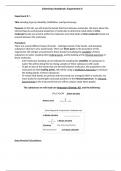
CHEM 121 Lab 5 Bonding Type by Solubility, Distillation, and Spectroscopy (Portage learning)
Title: Bonding Type by Solubility, Distillation, and Spectroscopy Purpose: In this lab, we will study the bonds that form between molecules. We learn about the Infrared Spectra and physical properties of molecules to determine what kinds of intramolecular bonds are present within the molecules and what kinds of inter-molecular bonds are present between the molecules. Procedure: There are several different types of bonds – Hydrogen bonds, Polar bonds, and Nonpolar substances that form ver...
- Other
- • 11 pages •
Title: Bonding Type by Solubility, Distillation, and Spectroscopy Purpose: In this lab, we will study the bonds that form between molecules. We learn about the Infrared Spectra and physical properties of molecules to determine what kinds of intramolecular bonds are present within the molecules and what kinds of inter-molecular bonds are present between the molecules. Procedure: There are several different types of bonds – Hydrogen bonds, Polar bonds, and Nonpolar substances that form ver...
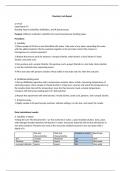
CHEM 121 lab 5 Bonding Type by Solubility, Distillation, and IR Spectroscopy (Portage learning)
Experiment # 5 Bonding Type by Solubility, Distillation, and IR Spectroscopy Purpose: Different methods to identify inter and intramolecular bonding types. Procedure: A. Solubility 1) Place sample of KCl into a test tube filled with water. Take note of any layers separating the water with the added material. Mix the materials together in the test tube. Note if the mixture is homogenous or remains separated. 2) Repeat the process each for pentane, n-propyl chloride, ethyl alcohol, n-butyl...
- Other
- • 4 pages •
Experiment # 5 Bonding Type by Solubility, Distillation, and IR Spectroscopy Purpose: Different methods to identify inter and intramolecular bonding types. Procedure: A. Solubility 1) Place sample of KCl into a test tube filled with water. Take note of any layers separating the water with the added material. Mix the materials together in the test tube. Note if the mixture is homogenous or remains separated. 2) Repeat the process each for pentane, n-propyl chloride, ethyl alcohol, n-butyl...
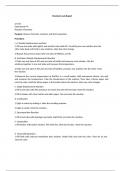
CHEM 121 Lab 4 Reaction Chemistry (Portage learning) SPRING
Experiment # 4 Reaction Chemistry Purpose: Review chemistry reactions and their properties Procedure: I. A. Double Displacement reactions 1) Fill one test tube with AgNO3 and another tube with HCl. Carefully pour one solution into the other tube back and forth to mix solutions. Note the color change. 2) Repeat the previous steps with one tube of Pb(NO3)2 and KI. B. Acid-Base (Double Displacement) Reaction 1) Take one test tube of HCl and one tube of NaOH and measure each solution. Mix t...
- Other
- • 3 pages •
Experiment # 4 Reaction Chemistry Purpose: Review chemistry reactions and their properties Procedure: I. A. Double Displacement reactions 1) Fill one test tube with AgNO3 and another tube with HCl. Carefully pour one solution into the other tube back and forth to mix solutions. Note the color change. 2) Repeat the previous steps with one tube of Pb(NO3)2 and KI. B. Acid-Base (Double Displacement) Reaction 1) Take one test tube of HCl and one tube of NaOH and measure each solution. Mix t...
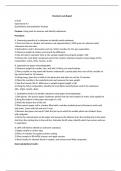
CHEM 121 Lab 3 Quantitative and Qualitative Analysis (Portage learning) SPRING
Experiment # 3 Quantitative and Qualitative Analysis Purpose: Using tools to measure and identify substances. Procedure: A. Measuring quantity of a substance to identify metal carbonate. 1) Tare test tube in a beaker and measure out approximately 1.1809 gram of unknown metal carbonate into test tube. 2) Add sulfuric acid to the beaker and mix. Watch reaction for CO2 gas evaporation. 3) Measure weight of mixture and record the difference. 4) Use formula to calculate %CO2 in the sample=we...
- Other
- • 2 pages •
Experiment # 3 Quantitative and Qualitative Analysis Purpose: Using tools to measure and identify substances. Procedure: A. Measuring quantity of a substance to identify metal carbonate. 1) Tare test tube in a beaker and measure out approximately 1.1809 gram of unknown metal carbonate into test tube. 2) Add sulfuric acid to the beaker and mix. Watch reaction for CO2 gas evaporation. 3) Measure weight of mixture and record the difference. 4) Use formula to calculate %CO2 in the sample=we...
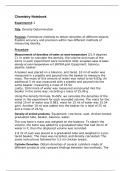
CHEM 121 Lab 2 Density Determination (Portage learning)
Title: Density Determination Purpose: Familiarize methods to obtain densities of different objects. Explore accuracy and precision within two different methods of measuring density. Procedure: Measurement of densities of water at room temperature (21.4 degrees C). In order to calculate the density, the volume and mass of the items in each experiment were recorded. Note: accepted value of water density at room temperature is 0.997904 g/ml. Equipment: balance, pipette, beaker. A beaker was...
- Other
- • 7 pages •
Title: Density Determination Purpose: Familiarize methods to obtain densities of different objects. Explore accuracy and precision within two different methods of measuring density. Procedure: Measurement of densities of water at room temperature (21.4 degrees C). In order to calculate the density, the volume and mass of the items in each experiment were recorded. Note: accepted value of water density at room temperature is 0.997904 g/ml. Equipment: balance, pipette, beaker. A beaker was...
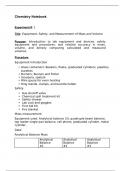
CHEM 121 Lab 1 notebook : Equipment, Safety, and Measurement of Mass and Volume (Portage learning)
Experiment #: 1 Title: Equipment, Safety, and Measurement of Mass and Volume Purpose: Introduction to lab equipment and devices, safety equipment and procedures, and relative accuracy in mass, volume, and density comparing calculated and measured volumes. Procedure: Equipment Introduction Glass containers: Beakers, flasks, graduated cylinders, pipettes, burettes Burners- Bunsen and Fisher Scoopula, spatula Wire gauze for even heating Ring stands, clamps, and burett...
- Other
- • 4 pages •
Experiment #: 1 Title: Equipment, Safety, and Measurement of Mass and Volume Purpose: Introduction to lab equipment and devices, safety equipment and procedures, and relative accuracy in mass, volume, and density comparing calculated and measured volumes. Procedure: Equipment Introduction Glass containers: Beakers, flasks, graduated cylinders, pipettes, burettes Burners- Bunsen and Fisher Scoopula, spatula Wire gauze for even heating Ring stands, clamps, and burett...
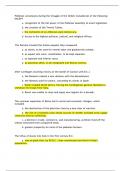
HIEU 201 Quiz The Roman Republic
Plebeian concessions during the Struggle of the Orders included all of the following EXCEPT a. recognition of the full power of the Plebeian Assembly to enact legislation. b. the creation of the Twelve Tables. c. the institution of an Athenian-style democracy. d. access to the highest political, judicial, and religious offices. The Romans treated the Italian peoples they conquered a. as slaves, to be used for menial labor and gladiatorial combat. b. as equals who were, nonetheless, to be...
- Other
- • 4 pages •
Plebeian concessions during the Struggle of the Orders included all of the following EXCEPT a. recognition of the full power of the Plebeian Assembly to enact legislation. b. the creation of the Twelve Tables. c. the institution of an Athenian-style democracy. d. access to the highest political, judicial, and religious offices. The Romans treated the Italian peoples they conquered a. as slaves, to be used for menial labor and gladiatorial combat. b. as equals who were, nonetheless, to be...
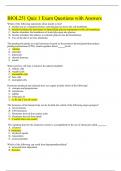
BIOL251 Quiz 1 Exam Questions with Answers
BIOL251 Quiz 1 Exam Questions with Answers Which of the following statements about insulin is true? A. Insulin acts as a transport protein, carrying glucose across the cell membrane. B. Insulin facilitates the movement of intracellular glucose transporters to the cell membrane. C. Insulin stimulates the breakdown of stored glycogen into glucose. D. Insulin stimulates the kidneys to reabsorb glucose into the bloodstream. E. Two of the above are true statements. The parathyroid glands are s...
- Other
- • 9 pages •
BIOL251 Quiz 1 Exam Questions with Answers Which of the following statements about insulin is true? A. Insulin acts as a transport protein, carrying glucose across the cell membrane. B. Insulin facilitates the movement of intracellular glucose transporters to the cell membrane. C. Insulin stimulates the breakdown of stored glycogen into glucose. D. Insulin stimulates the kidneys to reabsorb glucose into the bloodstream. E. Two of the above are true statements. The parathyroid glands are s...
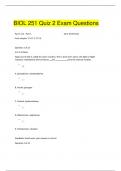
BIOL 251 Quiz 2 Exam Questions WALDEN
Part 1 of 6 - Part 1 40.0/ 60.0 Points From chapter 17 (17.1-17.11) Question 1 of 25 4.0/ 4.0 Points Stage one of GAS is called the alarm reaction. This is short-term stress, the fight-or-flight response, mediated by the hormones and from the adrenal medulla. • A. Epinephrine; norepinephrine • B. Insulin; glucagon • C. Cortisol; hydrocortisone • D. Aldosterone; angiot
- Exam (elaborations)
- • 21 pages •
Part 1 of 6 - Part 1 40.0/ 60.0 Points From chapter 17 (17.1-17.11) Question 1 of 25 4.0/ 4.0 Points Stage one of GAS is called the alarm reaction. This is short-term stress, the fight-or-flight response, mediated by the hormones and from the adrenal medulla. • A. Epinephrine; norepinephrine • B. Insulin; glucagon • C. Cortisol; hydrocortisone • D. Aldosterone; angiot

BIOD 101 Exam 1 portage learning
ECON 528 Final Exam (University of louisiana
CHEM 103 Module 5 Problem Set 2023 Portage learning
BIOD 101 Exam 1 portage learning
CHEM 121 Module 4 exam (Portage learning) SPRING 2024